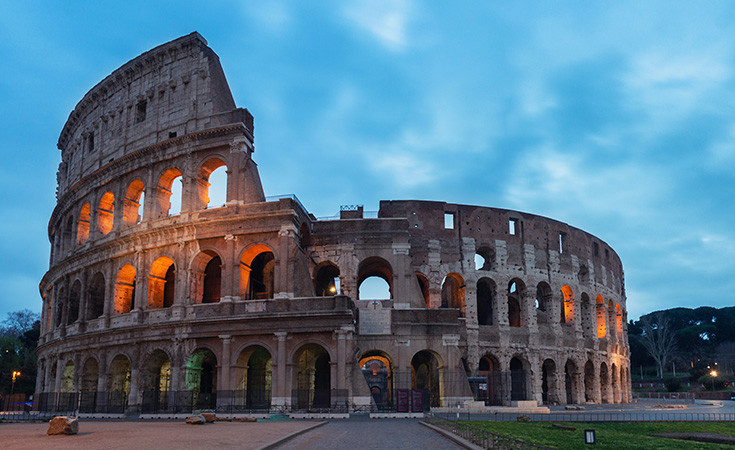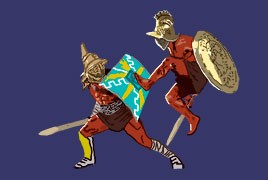
It is the greatest remaining structure of once most powerful empire that the world has seen. It is a symbol of the city of Rome and the building that almost every person in the world knows about. It was a symbol of power where slaves and free men searched for fame and glory. Over time Colosseum lost its purpose till it finally became a tourist symbol showing just a glance of its former glory to the pilgrims from all over the world.
 Colosseum is an amphitheatre, a structure that was used in Ancient Rome as a place for public spectacles. These spectacles varied from duels of gladiators, gladiators and animals (bears, crocodiles, lions, tigers ets.) to re-enactments of historical battles and executions. Colosseum was originally known as Flavian Amphitheatre (Aphitheatrum Flavium) because it was constructed by one of the dynasties of the Ancient Roman Imperators called the Flavian dynasty (ruled from 69 AD till 96 AD). The construction of this colossal building started in 70AD during the rule of the first member of the dynasty, Vespasian, and was finished by his son and successor Titus in 80AD. According to some sources, the funds needed for such a colossal project were gathered from the loots of war, even those from the Great Jewish Revolt in 70AD and the siege of Jerusalem.
Colosseum is an amphitheatre, a structure that was used in Ancient Rome as a place for public spectacles. These spectacles varied from duels of gladiators, gladiators and animals (bears, crocodiles, lions, tigers ets.) to re-enactments of historical battles and executions. Colosseum was originally known as Flavian Amphitheatre (Aphitheatrum Flavium) because it was constructed by one of the dynasties of the Ancient Roman Imperators called the Flavian dynasty (ruled from 69 AD till 96 AD). The construction of this colossal building started in 70AD during the rule of the first member of the dynasty, Vespasian, and was finished by his son and successor Titus in 80AD. According to some sources, the funds needed for such a colossal project were gathered from the loots of war, even those from the Great Jewish Revolt in 70AD and the siege of Jerusalem.
Colosseum is the largest amphitheatre in the world and according to some estimates it could hold between 50 and 80 thousand people. The location chosen for the construction of the amphitheatre was quite particular. After the great fire in 68AD, the last member of Julio-Claudian dynasty seized the devastated area and built a huge palace “Domus Aurea” with gardens, occupying entire 1.2km2. This complex even had an artificial lake, which was filled in after the death of Nero and on this spot the Colosseum was build. Some argue that this was even a symbolic gesture of returning to the people what Nero appropriated for his personal use. This is the reason why Roman Amphitheatre is situated in the city center and not on the outskirts of the city like everywhere else in the Empire.
In 217 AD, Colosseum was badly damaged by a fire probably caused by a lightning and it was not fully rebuilt until 240AD. The building went through a number of restorations until it finally lost its purpose. The latest gladiator fights were mentioned around 435AD, but the animal hunts continued till 523AD. In the 6th century, a small church was built in the arena and the arena was also used as graveyard. Till the 12th century, the huge empty space underneath the stands once used by spectators was converted into shops and housing. Afterwards, it was even used as a castle until the year 1349 when the building was severely damaged by a massive earthquake. At one point, a religious order moved in and kept occupied one part of the structure till as late as 19th century. Over the time, once glorious Colosseum was stripped of building materials which were reused elsewhere. The façade of this monument was rebuilt in 1807 and 1827, the interior was repaired in 1831, 1846 and in 1930, while during the reign of Benito Mussolini the arena was fully excavated.
Ticket prices for Colosseum in Rome
 The ticket is valid also for Roman Forum which is right next to the Colosseum.
The ticket is valid also for Roman Forum which is right next to the Colosseum.
Regular ticket price is 16 Euros (€). If you buy tickets online then there is additional booking charge 2 euros.
Free entrance: individuals younger than 18.
We advise you to check the ticket price before visiting on the official website of the Coliseum in Rome.
Working hours of Colosseum in Rome
 From last Sunday in October to 15th February working hours are: 8:30-16:30h (last entrance 15:30)
From last Sunday in October to 15th February working hours are: 8:30-16:30h (last entrance 15:30)
From February 16th to March 15th working hours are: 8:30-17:00h (last entrance 16:00)
From March 16th to last Saturday of March working hours are: 8:30-17:30h (last entrance 16:30)
From Last Sunday in March to 31st August working hours are: 8:30-19:15h (last entrance 18:15)
From September 1st to September 30th working hours are: 8:30-19:00h (last entrance 18:00)
From October 1st to last Saturday of October working hours are: 8:30-18:30h (last entrance 17:30)
Closed: January 1st, May 1st, December 25th.
(!) If the number of visitors reaches 3000, the rate of visitors entering the monument can be slowed down or even stopped for the security reasons.
We advise you to check the working hours before visiting on the official website of the Coliseum in Rome.
Interesting facts